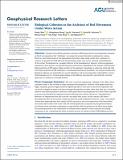Biological cohesion as the architect of bed movement under wave action
Abstract
Cohesive extracellular polymeric substances (EPS) generated by microorganisms abundant on Earth are regarded as bed “stabilizers” increasing the erosion threshold in sedimentary systems. However, most observations of this phenomenon have been taken under steady flow conditions. In contrast, we present how EPS affect the bed movement under wave action, showing a destabilization of the system. We demonstrate a complex behavior of the bio‐sedimentary deposits, which encompasses liquefaction, mass motion, varying bed formations and erosion, depending on the amount of EPS present. Small quantities of EPS induce higher mobility of the sediments, liquefying an otherwise stable bed. Bed with larger quantities of EPS undergoes a synchronized mechanical oscillation. Our analysis clarifies how biological cohesion can potentially put coastal wetlands at risk by increasing their vulnerability to waves. These findings lead to a revised understanding of the different roles played by microbial life, and their importance as mediators of seabed mobility.
Citation
Chen , X , Zhang , C , Townend , I , Paterson , D M , Gong , Z , Jiang , Q , Feng , Q & Yu , X 2021 , ' Biological cohesion as the architect of bed movement under wave action ' , Geophysical Research Letters , vol. 48 , no. 5 , e2020GL092137 . https://doi.org/10.1029/2020gl092137
Publication
Geophysical Research Letters
Status
Peer reviewed
ISSN
0094-8276Type
Journal article
Description
Funding for this project was provided by the National Key Research and Development Project, MOST, China (2018YFC0407506), the National Natural Science Foundation of China (51620105005), and the China Postdoctoral Science Foundation (2020M680580). D. M. Paterson acknowledges NERC funding (NE/N016009/1).Collections
Items in the St Andrews Research Repository are protected by copyright, with all rights reserved, unless otherwise indicated.

